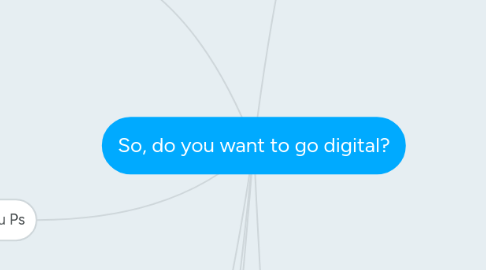
1. 1.ASK Two key questions:
1.1. Digital marketing: yes or no
1.1.1. Is my audience online/is it going to be online?
1.1.2. Are my products/services/brands suited to digital marketing?
2. 2. Form strong digital foundations
2.1. Know your business
2.2. Know the competition
2.2.1. Who are the digital competitors
2.2.2. Are they the same as your offline competitors?
2.2.3. What are they doing (good or wrong)
2.2.4. How can you differentiate from them
2.3. know your costumers
2.3.1. Who are and what do they want
2.4. Know what to do you want to achieve
2.5. Know how you're doing
3. 3. Understand the digital consumer
3.1. Key traits of the online consumer
3.1.1. Digital consumer are comfortable with the medium
3.1.2. They are vocal
3.1.3. They are fickle
3.1.4. They are in control
3.1.5. They want it all and they want it now
3.2. Using influencers
3.2.1. Online opinion leaders
3.2.2. An influencer agreed to three or more of the following statements
3.2.2.1. They consider themselves expert in certain areas
3.2.2.2. People ask their advice about purchases
3.2.2.3. If they like a product, they tend to recommend it to friends
3.2.2.4. Have a large social circle
3.2.2.5. They are active online
4. 4. Mind you Ps
4.1. Place: internet
4.2. Price: you have to be competitive and transparent
4.3. Product: a product that delivers tangible benefits and fills a real need in the marketplace
4.4. Promotion
4.4.1. Your website
4.4.2. SEO
4.4.3. Pay per click search advertising
4.4.4. Strategic partnerships
4.4.5. Online public relations
4.4.6. Social media
4.4.7. e-mail marketing
4.4.8. mobile marketing
4.4.9. Customer relationship management
4.4.10. Content marketing
4.4.11. Display media
5. 5. Eyes on the prize
5.1. Set realistic goals
6. Seven Keys:
6.1. Interconnectivity
6.2. Technology is giving information power to the costumer
6.3. Filtering is relevant
6.4. Niche aggregation is growing
6.5. publishing personal content
6.6. Rise of the prosumer
6.7. On-demand
6.8. A
7. 6. Build your channel
7.1. Your website is your place of business. Always have a conversion goals in mind
7.2. An effective website is the convergence of:
7.2.1. your bussines goals
7.2.2. the needs of you target market
7.3. Main steps of building a website
7.3.1. planning
7.3.2. Design
7.3.3. Development
7.3.4. Testing
7.3.5. Responsive web design
7.3.6. Deployment
7.4. Before start...
7.4.1. Know why you are building a website
7.4.2. Know who your website is for
7.4.3. Build usability and accessibility
7.4.3.1. Usability: simple, elegant and functional design helps users to achieve what they want to achieve online more effectively
7.4.3.2. Accessibility: design your website equally accessible to everyone
7.5. Choosing your domain name
7.5.1. You can use: www.mydomain.com
7.5.2. Tips
7.5.2.1. Make it catchy, memorable an relevant
7.5.2.2. Use a country-specific top level domain to appeal to a local audience
7.5.2.3. You can buy multiple domain names
7.5.3. Consider different suffixes
7.5.4. Keywords in a domain name can be beneficial
7.6. Hosting: your website's home on the internet
7.6.1. Types of hosting
7.6.1.1. Cloud based hosting
7.6.1.2. Virtual dedicated hosting
7.6.1.3. Dedicated hosting
7.6.1.4. Shared hosting accounts: most common and cheapest
7.6.1.5. Server co-location
7.6.2. Choosing your hosting company
7.6.2.1. Choose a host in the country where your primary target market lives
7.6.2.2. Make sure the host is reliable
7.6.2.3. What sort of support do they offer
7.6.2.4. Backup and disaster recovery
7.7. Choose a web designer/developer
7.7.1. Look at their own website
7.7.2. Examine their portfolio
7.7.3. Ask their costumers for recommendation
7.7.4. Dig into their online reputation
7.7.5. Are they designing sites to be found
7.7.6. Do they adhere to web standarts
7.8. Arrange your information
7.8.1. Start with the keywords
7.8.2. Define your content structure
7.8.3. Homepage: a central reference point for navigating your content. Shoul be a jumping off point for the rest of the site
7.9. Writing effective web content
7.9.1. Grab attention
7.9.2. Make it scannable
7.9.3. Make it original
7.9.4. Use the inverted pyramid
7.9.5. Be consistent
7.9.6. Engage with your reader
